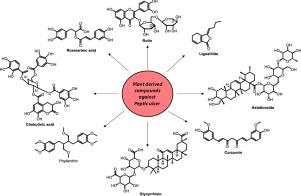South African Journal of Botany ( IF 3.1 ) Pub Date : 2021-01-06 , DOI: 10.1016/j.sajb.2020.11.030 Mukta Gupta , Bhupinder Kapoor , Reena Gupta , Naresh Singh

|
Background
Peptic ulcer (PU) is a collective term used for a group of chronic manifestations that affect mucosal integrity of stomach and/or duodenal lining. It is characterized by pain, perforations, bloating, nausea, blood in stool or vomit, loss of appetite and weight loss.
Purpose
Although a number of conventional treatment approaches such as antihistaminics, proton pump inhibitors, prostaglandins, antacids and antimicrobial agents are available for the management of PU, but they all are associated with various side effects. Herbal drugs are alternative remedies for the treatment of various pharmacological conditions and are generally considered to be much safer as compared to synthetic drugs. The present review summarizes the different phytoconstituents that have been explored for their antiulcer potential in various preclinical studies.
Methods
Literature search was conducted across four electronic databases (Google, PubMed, Web of Science and Scopus) for potentially relevant literature. Search was performed using various key words such as “peptic ulcer”, “herbal drugs”, “anti-ulcer”, “anti-ulcer plants”, “phytomedicine for peptic ulcer”, and “plant derived drugs for peptic ulcer”. Further studies were screened through examination of abstracts, reference sections and well on the basis of previously published review articles.
Results
A number of natural products are reported to exhibit antiulcer property in various animal studies and some of them are currently being used in various herbal formulations. Prominent phytoconstituents exhibiting anti-ulcerogenic activity include friedelin (Maytenus robusta Reissek); squalene (Muntingia calabura L.); brasiliensic acid (Calophyllum brasiliense Cambess.); shogaol (Zingiber officinale Roscoe); allitridin (Allium sativum L.); rutin (Stryphnodendron rotundifolium Mart.); ligustilide (Angelica sinensis (Oliv.) Diels); curcumin (Curcuma longa L.); and rosmarinic acid (Ocimum tenuiflorum L.).
Conclusion
Phytoconstituents have been reported to exhibit antiulcer property by targeting various enzymes, inflammatory mediators and/or by other pathways. Although they have shown promising results in preclinical studies, however, further research is required to ensure their safety and efficacy in human beings.
中文翻译:

用于治疗消化性溃疡的植物和植物化学物质:概述
背景
消化性溃疡(PU)是一个集体术语,用于表示影响胃和/或十二指肠内膜粘膜完整性的一组慢性表现。它的特点是疼痛,穿孔,腹胀,恶心,便血或呕吐物,食欲不振和体重减轻。
目的
尽管许多常规治疗方法(例如抗组胺药,质子泵抑制剂,前列腺素,抗酸药和抗微生物剂)可用于PU的治疗,但它们均与各种副作用相关。草药是用于治疗各种药理状况的替代药物,并且与合成药物相比,草药通常被认为更安全。本综述总结了在各种临床前研究中已探索出其抗溃疡潜力的不同植物成分。
方法
文献检索通过四个电子数据库(Google,PubMed,Web of Science和Scopus)进行,以寻找可能相关的文献。使用诸如“消化性溃疡”,“草药”,“抗溃疡”,“抗溃疡植物”,“用于消化性溃疡的植物药”和“源自植物的用于消化性溃疡的药物”之类的关键词进行搜索。通过对摘要,参考章节的检查以及在先前发表的评论文章的基础上对进一步的研究进行筛选。
结果
据报道,许多天然产品在各种动物研究中均表现出抗溃疡作用,其中一些目前已用于各种草药配方中。表现出抗溃疡活性的突出的植物成分包括弗瑞德林(Maytenus Robusta Reissek);角鲨烯(Muntingia calabura L.); 芥酸(Calophyllum brasiliense Cambess。); shogaol(Zingiber officinale Roscoe); allitridin(大蒜)芦丁(Stryphnodendron rotundifolium Mart。); gust本内酯(当归Diels); 姜黄素(Curcuma longa L.); 和迷迭香酸(Ocimum tenuiflorum L.)。
结论
据报道,植物成分通过靶向多种酶,炎性介质和/或通过其他途径表现出抗溃疡特性。尽管它们在临床前研究中显示出令人鼓舞的结果,但是,需要进一步的研究来确保其在人类中的安全性和有效性。


























 京公网安备 11010802027423号
京公网安备 11010802027423号